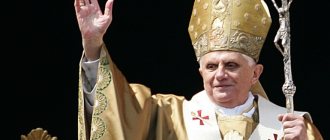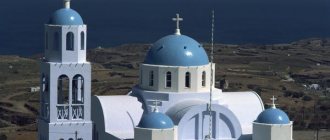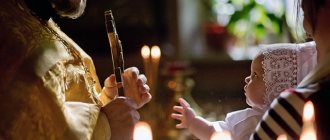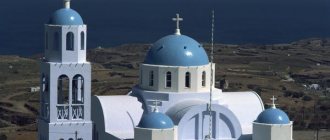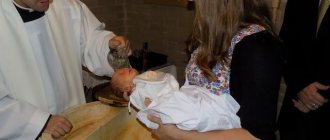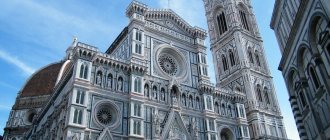The Pope is currently a very significant figure on the world stage. Of course, the modern head of the Catholic Church is far from the power that the medieval Catholic Church had, but the status of the pope is still very great. He is the main Catholic pontiff and the head of the Holy See, so the struggle for the post of Pope, who is elected after the death or resignation of the previous pope, flares up seriously.
The first supreme Roman pontiffs appeared during the Roman Empire, so the Pope can be considered one of the most ancient political figures in the world.
The emergence of the first Roman bishops
The first Christian preachers and bishops who appeared on the territory of the Roman Empire were constantly persecuted. Despite this, the role of the Pope became more and more significant with each century on the political map of Europe.
Having overcome paganism and established the Catholic faith in the territory of medieval Europe, the Catholic Church, through various reforms, was able to become so rich that European kings constantly asked it to borrow money. Due to this, the Catholic Church constantly “knocked out” various benefits for itself, which earned it considerable hatred from some representatives of noble families.
As for the first bishops who founded Christian communities among Roman slaves, there is negligible reliable information about them. The archives of the Catholic Church contain ancient manuscripts that testify to the high priests of Christians. These papers date back to the 1st-2nd centuries.
The first Roman bishop was Saint Peter himself, who shared the honor of founding the Roman Church with the Apostle Paul. Paul was most likely a citizen of the Roman Empire; he arrived in the Eternal City in 61. Peter came to Rome from the Roman province of Antioch, where he preached Christian teaching to his flock. It is certain that Peter appeared in Rome after Paul, where they met and suffered martyrdom.
It is with the actions of Saint Peter that the legend is connected about how, fleeing from Rome, he met Jesus Christ, who was going to again suffer martyrdom for Peter. It is most likely that the two apostles died at the hands of the Roman Emperor Nero in 64, although this is not known for sure.
Persecution of the first Roman bishops
According to the decrees and orders of the Roman emperors, Christians were persecuted for a long time. The first three centuries after the birth of Christ left practically no information about the Roman bishops, with the exception of their names. Almost all of the first bishops suffered martyrdom, which is currently known from legends that were later reflected in the “Book of High Priests.” It is believed that the first three centuries from the Nativity of Christ are the time of the first apostles, martyrs and persecution of Christianity.
Some Roman emperors were quite loyal to Christians, so they simply sent bishops into exile or isolated them from participation in social and public activities. It was due to the persecution and persecution of the first Christian bishops that this religion spread throughout Europe.
Literature[ | ]
- Gergely Yone.
History of the Papacy / Trans. from Hungarian O. V. Gromova. - M.: Republic, 1996. - 464 p. — ISBN 5-250-01848-3. [Orig. ed.: Gergely Jeno. A papasag tortenete. Budapest, 1982.] - Gottlieb A.G., Konsky P.A.
Papacy // Encyclopedic Dictionary of Brockhaus and Efron: in 86 volumes (82 volumes and 4 additional). - St. Petersburg, 1890-1907. - Grigulevich I. R.
Papacy. Century XX. - M.: Politizdat, 1981. - 2nd ed., additional. — 532 p. - Zadvorny V.L.
Works of the Roman pontiffs of the era of late Antiquity and the early Middle Ages (I-IX centuries). - M.: Franciscan Publishing House, 2011. - 480 pp.: ill. - ex canon law.
Codex Iuris Canonici. - M.: Institute of Philosophy, Theology and History of St. Thomas, 2007. - 624 p. — Series “Bibliotheca Ignatiana”. — ISBN 978-5-94242-045-1. - Kowalski Jan Wierusz.
Popes and papacy / Trans. from floor T. Trifonova. - M.: Politizdat, 1991. - 240 p. — ISBN 5-250-01237-X. - Lozinsky S. G.
History of the papacy. - M.: Politizdat, 1986. - 3rd ed. — 382 p. - Christianity. Encyclopedic Dictionary. - M., 1993-1995.
- Peter Frankopan.
First Crusade. Call from the East = Peter Frankopan. The First Crusade: The Call from the East. - M.: Alpina Nonfiction, 2018. - ISBN 978-5-91671-774-7. - Brusher, Joseph S.
Popes Through the Ages (unspecified). - Princeton, NJ: Van Nostrand, 1959. - Chamberlin, E.R.
The Bad Popes (unspecified). - New York: Dial Press (English) (Russian, 1969. - Dollison, John.
Pope-pourri (undefined). - New York: Simon & Schuster, 1994. - ISBN 978-0-671-88615-8. - Maxwell-Stuart, PG
Chronicle of the Popes: The Reign-by-Reign Record of the Papacy from St. Peter to the Present (English). - London: Thames and Hudson (English) (Russian, 1997. - ISBN 0-500-01798-0. - Norwich, John Julius (English) (Russian.
The Popes: A History (Unspecified). - London: Chatto & Windus (English) (Russian, 2011. - ISBN 978-0-7011-8290-8. - Barry, Rev.
Msgr. John F. One Faith, One Lord: A Study of Basic Catholic Belief. - New York: William H. Sadlier (English) (Russian, 2002. - ISBN 0-8215-2207-8. - Bokenkotter, Thomas.
A Concise History of the Catholic Church (unspecified). - New York: Doubleday, 2004. - ISBN 0-385-50584-1. - Chadwick, Henry (1990), The Early Christian Community, in John McManners, The Oxford Illustrated History of Christianity
, Oxford University Press, ISBN 0-19-822928-3
- Duffy, Eamon (English) (Russian.
Saints and Sinners, a History of the Popes (English). - Yale University Press, 1997. - ISBN 0-300-07332-1. - Durant, William James (English) (Russian.
The Story of Civilization (English) (Russian (English). - New York: Simon & Schuster, 1950. - Vol. IV. The Age of Faith: A History of Medieval Civilization - Christian, Islam, and Judaic - from Constantine to Dante, AD 325–1300 - ISBN 0-671-01200-2. - Durant, William James (English) (Russian.
The Story of Civilization (English) (Russian (English). - New York: Simon & Schuster, 1957. - Vol. VI. The Reformation. - ISBN 0- 671-61050-3. - Franzen, August;
Dolan, John. A History of the Church (undefined). — Herder and Herder (English) (Russian, 1969. - Granfield, Patrick.
The Limits of the Papacy: Authority and Autonomy in the Church. - New York: Crossroad, 1987. - ISBN 0-8245-0839-4. - Grisar, Hartmann.
History of Rome and the Popes in the Middle Ages (English). - London: Kegan Paul, Trench, Trübner, 1912. - John Paul II, Pope
Universi Dominici Gregis
(unspecified)
. Vatican Publishing House (22 February 1996). - Kelly, JN
Oxford Dictionary of the Popes (undefined). - Prentice Hall, 1986. - ISBN 978-0-19-190935-1. - Kerr, William Shaw (English) (Russian.
A Handbook on the Papacy (undefined). - London: Marshall, Morgan & Scott, 1950. - Hans Küng.
The Catholic Church: A Short History (unspecified). - Random House, 2003. - ISBN 978-0-8129-6762-3. - Loomis, Louise Ropes.
The Book of the Popes (Liber Pontificalis): To the Pontificate of Gregory I (English). - Merchantville, New Jersey: Evolution Publishing, 2006. - ISBN 1-889758-86-8. - Noble, Thomas;
Strauss, Barry. Western Civilization (undefined). - Houghton Mifflin (English) (Russian, 2005. - ISBN 0-618-43277-9. - Orlandis, José (English) (Russian.
A Short History of the Catholic Church (Unspecified). - Scepter, 1993. - ISBN 1-85182-125-2. - Pastor, Ludwig von (English) (Russian.
The History of the Popes, from the Close of the Middle Ages: Drawn from the Secret Archives of the Vatican and Other Original Sources (English). - London: J. Hodges, 1891–1930. - Walsh, James Joseph (English) (Russian.
The Popes and Science: The History of the Papal Relations to Science During the Middle Ages and Down to Our Own Time (English). - New York: Fordham University Press (English) ) (Russian, 1908.
The history of the first popes
The institution of the papacy appeared at the beginning of the 5th century, although the prerequisites for its appearance were already at the end of the 4th century. The institution of the papacy was formed in Rome, since it was there that the Christian community had lands that legally belonged to it by that time. The Roman episcopate was created, which was soon destined to become the center of Catholic power in Europe. After some time, Roman bishops began to officially bear the title of pope. In the 6th century, the Catholic Church was already a fairly influential organization.
The Franks played the main role in completing the papal throne. It was their king Pepin the Short who granted the entire Roman province to the episcopate. Thus, the city of Rome became the Papal States, and the Pope was not only the highest church nobility, but also a sovereign ruler. The Franks, who massively adopted Christianity under King Clovis in 496, provided all possible support to the Catholic Church, so the status of the pope under King Pepin the Short was very high.
The official title "Dad" appeared as follows:
- Even in ancient Rome, when Christian teaching was just emerging, all priests who had the right to bless their parishioners were called popes;
- After the Roman Emperor Constantine issued a law on freedom of religion in 313, and Christianity gradually began to receive the status of the official Roman religion, only bishops began to bear the title “pope”;
- When the Christian Church split into the Roman Catholic and Constantinople Orthodox, the papal rank began to be assigned only to Roman or Alexandrian bishops.
Before the Great Schism of the Christian Church occurred in 1054, the Pope was elected in Rome. All the secular and spiritual authorities who could reach Rome at the appointed time gathered and chose a new pope. In 1059, the Lutheran Council decided to put an end to this practice, and the election of the pope was now to take place at a conclave of cardinals, who were the first bishops of the Catholic Church.
The elected Pope had to publicly announce under what name he would represent the interests of the Catholic Church. If throughout the history of the papacy there have already been popes with such names, then a serial number is added to the name. After this, the Pope officially receives the throne name, by which he will be known throughout his reign.
The election of the Pope very rarely went smoothly. Since the early Middle Ages, the papal throne has constantly become hostage to the political ambitions of European secular rulers. The Catholic Church was constantly used in the struggle for socio-political influence in Europe, and many medieval monarchs acted quite harshly, especially during the early Middle Ages.
Closer to the period of the High Middle Ages, the struggle between spiritual and secular power intensified. Taking advantage of the fact that the Christian Church had fallen into decline due to the constant Viking raids that occurred between 793 and 1000, the German kings Otton began to place their puppets on the papal throne.
The peak of the confrontation between spiritual and temporal power occurred during the papacy of Gregory VII. Gregory publicly stated that the power of the Pope was stronger than the royal and imperial ones. This statement did not please the Holy Roman Emperor Henry IV, who ordered the Pope to be removed from office. In turn, Pope Gregory VII excommunicated the emperor and all his people from the church, which caused a storm of indignation among the emperor.
Henry IV, contrary to the orders of the pope, went to war against him, but lost. Abandoned by his comrades and deprived of troops, the emperor was forced to go beg for forgiveness from the pope. Gregory VII forgave the emperor, but already in 1084 Henry managed to capture Rome and force Pope Gregory to flee. Thus, the largest confrontation in history between the church and secular authorities ended in victory for the latter. Despite this, the power of the Catholic Church grew, and already in the 13th century no one in Europe doubted that the pope was more powerful than any European monarch.
Interesting Facts
- Known for personal modesty . I gave up luxury apartments, a dad car, and a personal chef. Like his namesake Francis of Assisi, he is devoted to the ideals of evangelical poverty.
- In his youth, he worked as a bouncer in a nightclub.
- He is a football fan , a fan of the San Lorenzo club from Buenos Aires.
- On the first Maundy Thursday after the enthronement, he washed the feet of 12 minor prisoners , among whom were two girls (a Catholic and a Muslim). With his gesture, the new Pope set an example of mercy for teenagers at the very bottom of their lives.
- The English magazine "Time" recognized him as "Person of the Year 2013".
- The pope's email to Gustavo Vera, the chairman of the Latin American Society Against Drug Abuse, caused a diplomatic row. The reason for this was the desire expressed by the pontiff to prevent the “Mexicanization” of Argentina. The topic of such an unfortunate e-mail was the rampant drug mafia in Latin America. The indignation of the Mexican side knew no bounds, but the Vatican press service stated that a personal letter should not become a reason for such a quarrel and His Holiness did not want to offend anyone, he only emphasized the danger of increasing drug trafficking.
Rights and duties of the Pope
The Pope is considered the monarch and sovereign of the Holy See. At its core, the Pope is the direct successor of the Apostle Peter. The power of the pope extends to all Catholics in the world and has no territorial significance. In addition, the head of the Holy See is at the same time the only head of the Vatican City State, where the residence and reception of the pope is located. The head of the Catholic Church bears the following titles:
- Bishop of Rome;
- Successor of Saint Peter;
- Vicar of Christ;
- Pontifex Maximus;
- Servant of God's servants;
- Primate of Italy;
- Archbishop and Metropolitan of the Roman Province;
- Supreme High Priest of the Universal Church.
Most of the above titles have a spiritual meaning, clearly denoting the role of the pope in the Catholic Church and Christendom.
If we take the role of the head of the Catholic Church in international law, then the pope is an independent entity endowed with spiritual and legal authority. The main responsibilities of the head of the Catholic Church are as follows:
- Maintain the Christian faith by personal example;
- Contribute to its dissemination and approval;
- Administration of the Catholic Church;
- Publish canons;
- Appoint priests to positions;
- Confer ecclesiastical ranks;
- To administer within the framework of the system of ecclesiastical government of the Catholic Church.
Catholics believe that any Pope is a direct spiritual descendant of the Apostle St. Peter, to whom Jesus Christ himself entrusted the reins of government and service to the Lord. Every Catholic has the right to the position of high priest, since theoretically this rank can be transferred to any person from among the Catholics who is worthy of it. In practice, only one of the bishops can become pope.
Current Supreme Pontiff
The current Pope's name is Francis. The worldly name is Jorge Mario Bergoglio. He is Argentine by nationality and was previously the Archbishop of Buenos Aires.
short biography
The future head of the Vatican was born on December 17, 1936. He was the eldest of five children in the family. His father worked on the railroad, and his mother was a housewife and raised children.
Already in childhood, the boy was distinguished by kindness and courtesy. After graduating from school, he entered a technical college to become a chemist, where he successfully defended his diploma. Then he got a job in his specialty in a chemical laboratory.
At the age of 21, he suffered severe pneumonia, which almost ended in his death. After illness, I decided to devote my life to serving God.
In 1958 he joined the Society of Jesus.
He studied at his hometown's St. Joseph's College and received a degree in philosophy and a teaching license in 1967. Afterwards he taught at Catholic educational institutions in the capital and Santa Fe.
Became a priest at the age of 33 , continued his spiritual studies at the University of Alcalá de Henares and graduated in 1971.
In 1973, he took a vow of submission to the Pope and received the title of Provincial Superior of Argentina.
He was recognized as an auxiliary bishop of the capital in 1992, and after some time he was consecrated bishop.
By 1998 he became cardinal priest of the Cathedral of San Roberto Bellarmino. In this position, he received a post in the administration of the Holy See and the Vatican - in the Roman Curia.
From 2005 to 2011 he was the head of the country's Bishops' Conference.
In 2013, the Catholic world was shocked by the news of the abdication of the then-current pontiff Benedict XVI. On this occasion, a conclave was held, where Jorge Mario Bergoglio was elected as the new ruler of the Vatican. He chose Francis, the patron saint of the poor, as his new name.
Significant Events
Pope Francis is close to the people, as evidenced by his actions:
- Not yet being Supreme Pontiff, in 2001 he personally visited a hospital where poor people were dying of AIDS.
- In 2016, a significant meeting took place with Patriarch Kirill. For the first time since the great schism, a document was signed calling for pan-Christian unity.
- In 2022, Francis delivered a report against the death penalty. His initiative was supported by the governor of New York.
The current Pope is loved by the people. As a versatile and wise ruler, he opposes social inequality and believes that all people are worthy of respect.
Catholics hope that his reign will bring prosperity to the country and strengthen people's faith in God.
The most famous personalities in the history of the papacy
The history of the development of the Catholic Church is connected not only with Christian spiritual life, but also with a number of political events that took place in Europe after the fall of the rule of Rome. Over the centuries, the Catholic Church strengthened its power, and some rich monasteries often became real oppressors for the common people.
The entire period of formation of the papacy can be divided into the following segments:
- Pre-Nicene period I-III centuries. The most difficult time for the first Christian communities. In those years, the Christian religion was considered illegal, and all its followers were persecuted by both the authorities and the common people. Despite this, it was the first Christians who, through their exploits, proved to all of Europe that they were ready to accept martyrdom rather than renounce their religion. Witnesses of the torment and spiritual strength of the first Christians were often also baptized and became the same martyrs;
- From 313 to 493, Christianity was able to establish itself as the state religion of the Roman Empire. In 313, a law on freedom of religion was issued. In 380, Emperor Theodosius the Great made Christianity the state religion, prohibiting sacrifices;
- Ostrogothic period, which lasted until 537. At this time, Christianity experienced difficult times. The barbarians who destroyed the Roman Empire persecuted Christians;
- The Byzantine period of the papacy was quite calm. It lasted until 752;
- Frankish period, which lasted until 857. Since the Franks were baptized back in 496 (possibly in 498 or 503), Christians lived quite well during this period, although closer to the beginning of the 9th century, pagan Vikings began to plunder the monasteries;
- The era of papal humiliation on the part of European monarchs lasted until 1048. The Vikings, who captured and plundered many European lands, despised the Christian religion for many years;
- From 1048 to 1257 the Catholic Church reached the peak of its power. The Pope could dictate his terms even to European monarchs;
- The transitional period of instability, reformation and counter-reformation lasted from 1257 to 1585;
- Age of Enlightenment (from 1585 to 1689);
- The era of gradual weakening of the power of the Catholic Church;
- The era of modern times, which was marked by the return of the sovereign status to the Pope.
According to historians, the most monumental pope was Urban II, who ushered in the era of the Crusades. It was he who contributed to the creation of monastic knightly orders, which subsequently redrew the political map of Europe in accordance with their interests.
Another significant figure in the history of the Catholic Church was Gregory IX, who entrusted the Dominican Order with carrying out the Inquisition.
Content
- 1 Title 1.1 Official title of the Pope
- 1.2 Spelling of the term
- 2.1 Title
- 3.1 Election of the Pope
- 4.1 The power of the pope in the Church
Features of the papacy during periods of instability
The period from 1309 to 1377 is considered one of the most problematic in the history of the Catholic Church. In those years, France strengthened its influence on the world political stage. The French king Philip the Fair was greatly concerned about the enormous influence of the Catholic clergy and demanded unquestioning submission from Pope Benedict XI.
As a result of the conflict, the French monarch removed the Pope from office, appointing instead his compatriot Bishop Bertrand, who became known as Clement V. To show his power, Philip the Fair ordered the papal residence to be moved to the city of Avignon. Clement V himself was an ambitious man. It was he who began the persecution of the Templar Order, which ended in its complete defeat and destruction. In 1312, the Templar Order was banned.
In 1377, thanks to the efforts of Pope Gregory XI, the papal throne returned to Rome. Despite this, the Catholic Church was already greatly weakened and lost its unity. A period of dual power began, when several people claimed the papal throne at once. The meetings took place either in the Vatican or in Avignon. Only in 1417, with the arrival of Martin V to the Holy See, was it possible to solve this problem.
A hundred years later, in 1517, the period of reformation began in Europe. It is associated with the religious teachings of Martin Luther, who fought against the Latinization of the church. This teaching, called Lutheranism, quickly became popular among the peasant masses, as Luther made religion easier for the common man to understand. Some of the popes made concessions to the reformers, making changes to the rituals. Because of this, the role of the Catholic Church began to slowly but steadily decline.
Soon the period of reformation was over, and the period of counter-reformation began. All heretics were outlawed. Thousands of them were burned at the stake, and their property went to the treasury of the emperor. Thanks to this, all of Europe soon plunged into the chaos of religious civil wars. Catholics and Protestants violently destroyed each other, leaving cities and towns in ruins. The Troubles ended only in 1585, when the period of enlightenment began.
Notes[ | ]
- The official name is the Palace of Sixtus V.
- CAPITAL-LOWER - Tree (Russian). drevo-info.ru. Date accessed: February 1, 2022.
- Gergey E. History of the papacy: (Translated from Hungarian) - M.: Respublika, 1996. - 463 p.
- Some periods may be combined by authors into periods of longer duration; the dates of the periods may differ slightly. Main sources: Gergely, 1996; Kowalski, 1991; Lozinsky, 1986.[⇨]
- CCP, canon 332, paragraph 1
- CCP, canon 332, paragraph 2
- Pope Benedict XVI announces his resignation at the end of month (unspecified)
(inaccessible link). Access date: February 11, 2013. Archived February 11, 2013. - Pope Benedict XVI in shock resignation
- KKP, canon 331
- CCP, canon 333, paragraph 3
- Codicis Juris Canonici Fontes, Rome-Vatican, 1923-1929, Vol. 1-7 / ed. P. Gasparri; T. 8-9 / ed. Sheredi
- Frankopan, 2022, p. 37.
History of the papacy in modern times
In 1929, the Pope was able to regain his status as head of the Vatican City State. This marked the beginning of a new era of revival of the Catholic Church. Over the entire modern history of the papacy, eight Supreme Pontiffs were elected, each of whom was able to make his own contribution to the history of the Catholic Church. The new period is characterized by a number of reforms that the Catholic Church adopted in order to keep up with the trends of the new time.
In 1962, the Second Vatican Council was convened, at which Pope Paul VI considered it necessary to carry out a number of reforms in order to update the Catholic Church in connection with the realities of our time. This measure was forced, since after World War II the Catholic Church lost a huge number of parishioners who transferred to other religious denominations. This happened due to the fact that the Catholic Church strongly supported and collaborated with Nazi Germany. As a result of the council, which met for three years, the code of canon law was revised.
Pope John Paul II approved and signed the new code in 1983. Thanks to the actions of this Supreme Pontiff, who remained in this position for 27 years, the Catholic Church again acquired enormous authority and influence in modern society.
The current high priest is Francis, who is not European. This is an Argentine who became the first person of non-European origin to be confirmed as head of the Catholic Church.
The residence of the Pope is located in the Vatican. This is the Apostolic Palace, which is a work of architectural art. There is an archive, the Sistine Chapel, St. Peter's Cathedral and Library and many other places of worship.
Liturgies
The Roman Mass is an important part of the life of any person who professes Catholicism, and for everyone else it can be an interesting spectacle. The official Vatican website provides a schedule of liturgies celebrated in St. Peter's Basilica. The pope himself holds mass only on holidays; there are many visitors; it is recommended to arrive two hours before the start.
On Sunday morning (at 11 o'clock) Pope Francis reads the Angelus sermon to those gathered in St. Peter's Square from the window of his chambers . Sunday contains a special grace for Christians; everyone can see their shepherd and plunge into the atmosphere of unity with fellow believers.
